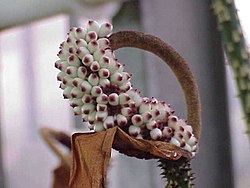| Anchomanes | |
|---|---|
 | |
| Anchomanes giganteus | |
| Scientific classification | |
| Kingdom: | Plantae |
| Clade: | Tracheophytes |
| Clade: | Angiosperms |
| Clade: | Monocots |
| Order: | Alismatales |
| Family: | Araceae |
| Subfamily: | Aroideae |
| Tribe: | Nephthytideae |
| Genus: | Anchomanes Schott |
Anchomanes is a genus of flowering plants in the family Araceae. The genus is native to tropical Africa. [1] [2]
Anchomanes is quite similar to species in the genera Dracontium and Amorphophallus, but there are a few apparent differences. One such difference is that the roots are perennial. Also, the stalks are spiny and the tuberous rhizomes have eyes. [3]